GENERAL ARMOR
DESCRIPTIONS
Buckler
or Target Shield:
A
buckler, also known as a target shield, is a small round shield of wood or
metal that fastens to the forearm. It can be worn by crossbowmen and archers
with no hindrance to their attacks with their chosen weapons. Because of its
small size (approximately 1' in diameter), a buckler protects against one
attack per melee round. The user can choose which attack he wishes to use
his buckler against, but he must declare this before the attack roll has been
made. This increases the defender's armor class only by 1 (more if magical)
against that single attack.
Notes: Bucklers should be treated not as full shields when determining the
armor class of the user, but more as a special item that can be called upon
to add extra protection for one attack per round.
If this shield is used with proficiency, it affords no additional AC to the user, but does allow for offhand shield-punches to be delivered that inflict 1d2 damage.
Small
Shield:
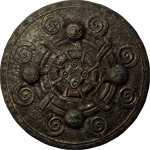 A
small shield is usually round and is carried on the forearm, gripped with
the shield hand. Its light weight as compared to a medium shield permits the
user to carry other items in that hand, although he cannot wield or carry
another weapon. A small shield (approximately 2' in diameter) can be used
to protect against two frontal attacks of the user's choice. Like the buckler
above, the user can choose which attacks to use his shield against, but must
decide before the attacks are rolled.
A
small shield is usually round and is carried on the forearm, gripped with
the shield hand. Its light weight as compared to a medium shield permits the
user to carry other items in that hand, although he cannot wield or carry
another weapon. A small shield (approximately 2' in diameter) can be used
to protect against two frontal attacks of the user's choice. Like the buckler
above, the user can choose which attacks to use his shield against, but must
decide before the attacks are rolled.
Notes: Like the buckler, the small shield should be considered a special item used
for defense, not as a general addition to frontal armor class.
If this shield is used with proficiency, it affords an additional +1 to AC (+2 total) to the user, and can be used for offhand shield-punches inflicting 1d3 damage.
Medium
Shield:
A
medium shield is carried in the same manner as a small shield (i.e., on the
forearm). Unlike the small shield, however, it's weight prevents the character
from using his shield hand for anything other than carrying the medium shield.
Medium shields are usually made of metal, range from 3'-4' in diameter, and
can be of any shape, from round to square to a spread dragon's wings.
A
typical medieval shield resembles a triangle with one point facing downward.
With a medium shield, a character can defend against any number of frontal
or flanking attacks in a given round. In this instance, the character applies
the +1 armor class bonus (not including magical bonuses) for the shield to
his overall armor class rating, providing he remembers to disregard the shield
bonus during the occasional attack from the rear.
Notes: If this shield is used with proficiency, it affords an additional +2 to AC (+3 total) to the user, and can be used for offhand shield-punches inflicting 1d4 damage. It can be used
to protect against three frontal attacks of the user's choice.
Body
Shield (Tower Shield):
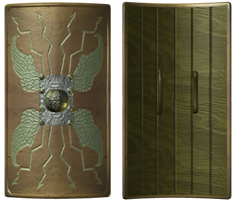 The
body shield, also known as the kite or tower shield, is a massive metal or
wooden shield reaching nearly from the chin to the toe of the user. It must
be firmly fastened to the forearm and the shield hand must firmly grip it
at all times. Naturally, this precludes use of the shield hand for anything
but holding the body shield in place.
The
body shield, also known as the kite or tower shield, is a massive metal or
wooden shield reaching nearly from the chin to the toe of the user. It must
be firmly fastened to the forearm and the shield hand must firmly grip it
at all times. Naturally, this precludes use of the shield hand for anything
but holding the body shield in place.
Standing
around 6' tall, the body shield provides a great deal of protection to the
user, improving the overall armor class of the character by 1 against melee
attacks and by 2 against missile attacks.
As with all shields, these bonuses
apply only against frontal and flanking attacks. Since the body shield is
very heavy, the DM may want to use the optional encumbrance system if he allows
its use in the campaign. This will help to prevent overuse of body shields
in combat.
Note: If this shield is used with proficiency, it affords an additional +2 to AC (+3 total) to the user against melee attacks and +4 against all missile attacks, and can be used for offhand shield-punches inflicting 1d6 damage. It can be used
to protect against four frontal attacks of the user's choice.
Padded
Armor (AC 7):
 Padded armor, also referred to as quilted armor, is the simplest form of manmade
armor. It consists of two or more layers of spun cloth stuffed with thick
batting and quilted together. Padded armor typically covers the chest and
shoulders, but full-length suits are sometimes seen.
Padded armor, also referred to as quilted armor, is the simplest form of manmade
armor. It consists of two or more layers of spun cloth stuffed with thick
batting and quilted together. Padded armor typically covers the chest and
shoulders, but full-length suits are sometimes seen.
Campaign
Use: Padded armor is mostly found among the poor and unskilled. Only the poorest
excuses for armed forces would be caught dead in padded armor. The bulky and
restrictive nature of the armor makes it a poor substitute for a stout set
of leather (q.v.). Village militias, neophyte bandit packs, urban street gangs,
and primitive barbarian hordes are the most common users of padded armor.
In
short, this includes anyone who cannot afford leather armor (i.e., the truly
destitute), cultures without the technology to tan hide (i.e., the truly primitive),
or those who have no other option at their time of need (i.e., the truly desperate).
Padded armor can be made by any race or nation. Thus, it is common protection
for the poorer classes. Since making a padded suit of armor requires little
more than a crude needle and thread, low-level or desperate adventurers in
need of additional protection can usually whip up a set of padded armor in
less than two days. The durability and level of comfort afforded by the homemade
suit naturally varies in direct proportion to the skill of the would-be armorer.
For
game purposes, several layers of heavy cloth or furs can be considered padded
armor for the purposes of determining a character's base armor class. Padded
armor, being little more than multiple layers of clothing, tends to soil and
wear out easily. Although newly fashioned sets may sell cheaply, padded armor
must be replaced often, even if it is well cared for. Lice, sweat, dirt, fleas,
and insects all take their toll. If the DM judges that a set of padded armor
has seen its last days, the armor class of the armor drops one place (AC 9).
The armor, now rotted and torn, is little more than bulky clothing. Importantly,
heavily soiled armor reduces the wearer's saving throws against disease and
disease-causing spells by -2. Under ideal conditions, a set of padded armor
should be replaced monthly.
However,
when traveling through heavily infested swamps or in monster-laden forests,
padded armor may require replacement as often as every few days. On any long
journey, spare sets of padded armor should be taken along as if they were
spare sets of clothing. Too much frugality before a journey can lead to much
discomfort later. Naturally, those who have no access to better armor try
to make the best appearance whenever they can. Nobody wants to appear cheap
or desperate, especially when they are. Therefore, decorating one's padded
armor is the most common form of "upgrading" the appearance of one's forces.
All armies and nations have banners and shields adorned with their own colors,
and these colors are often repeated in intricate patterns on their padded
armor.
This
is most often seen when the local king or noble quickly recruits the local
farmers' militia to defend his lands or aid him in launching an assault. The
wives, sisters, and daughters quickly whip up anything they can to protect
their ill-trained husbands, brothers, and sons. The colors of the lord are
either quilted into the design of the armor in checkerboard fashion, or painted
or dyed onto the hastily prepared protection. In similar fashion, the most
nefarious of evil knights have been known to use quilted armor to camouflage
their own soldiers as peasants of the opposing ranks, taking devious advantage
of the militia's known lack of combat training. This is only one of many reasons
why 0-level fighters are neither feared nor respected by the armed forces.
Certainly in the case of padded armor, one can tell a knave by his suit.
Leather
Armor (AC 8):
 Leather armor, despite the popular misconception, is not soft and supple like
the leather used to make a ranger's boots or a druid's robe. That kind of
leather offers no better protection than common clothing. Leather armor is
actually strong and stiff, having been hardened in boiling oil and then stretched
over a wooden or stone model of a man's or woman's chest. The resulting breastplate
and shoulder guards are combined with a tunic or kirtle and, in colder climes,
leggings of wool or soft leather.
Leather armor, despite the popular misconception, is not soft and supple like
the leather used to make a ranger's boots or a druid's robe. That kind of
leather offers no better protection than common clothing. Leather armor is
actually strong and stiff, having been hardened in boiling oil and then stretched
over a wooden or stone model of a man's or woman's chest. The resulting breastplate
and shoulder guards are combined with a tunic or kirtle and, in colder climes,
leggings of wool or soft leather.
Campaign
Use: This is the most common form of "modern" armor. The materials (leather
and oil) are readily available in all civilized lands. Only the techniques
for boiling and shaping the leather is necessary, and this is not a difficult
feat for a leatherworker. This armor is both inexpensive and durable. While
the leather is extremely stiff, it is never fashioned into anything larger
than a breastplate, which keeps restriction of movement to a minimum. Naturally,
this arrangement means leather armor affords no protection to the joints,
but this is true of most types of armor, and is a challenge all civilized
races have been attempting to overcome since wars began. In severe combat
situations, leather armor may need to be replaced weekly.
However,
the armor is easily cleaned, reasonably unaffected by weather, and resists
all but the severest of abrasions. This means a good set of leather can be
worn daily for many months without need for replacement. Many retired warriors
and middle-class militia have a set of leather armor stored away that they
take out and polish at least annually. Because raw leather comes from a byproduct
of medieval daily life (i.e., eating beef and other meats), in civilized societies
leather armor is very common. Even rural communities have little trouble manufacturing
leather armor for the troops within a few days. Cows are not the sole source
of hide for tanning. Horses, sheep, and camels can be used just as easily.
In short, the creature must have a thicker skin than that of a normal man,
but not quite as thick as that of an elephant of bear.
The
skins of these well-protected creatures, when tanned, becomes hide armor (q.v.).
Irregular human forces (e.g., militias and levies, freemen, commoners above
peasant level, barbarians, light infantry, and marines) are the primary users
of leather armor, for the following reasons: A) leather armor is drastically
cheaper and more readily available than metal armor; B) the armor can be worn
for long periods of time without leading to increased fatigue or disease;
C) the method or protection is so simple that many armies can make new sets
of armor from cattle seized in newly raided territories, often scant days
before meeting the defenders in battle; and D) they can be stockpiled for
years without the excessive maintenance required by metal armors that are
prone to rust.
Another
benefit of leather armor, much extolled by those of a more disreputable persuasion,
is the ease which it can be silenced. While leather armor is not typically
noisy, its buckles and fasteners tend to rattle and clink. Unlike metal armor,
leather armor is easily muffled by clothing and as such makes little sound
during normal movement. Additional layers of clothing further dampen sounds
made by the wearer while hiding. More rouges than can be counted owe their
lives to muffled leather armor. The freedom of movement, adequate general
protection, lack of noise, high availability, and low price make this the
armor of choice for the general human population.
Wood or Bone Armor (AC 7):
In primitive or savage settings,
metal may be unavailable for armor. Wood or bone lamellars and reinforced coats are not uncommon among people with little access to metal. Usually, armor of this type concentrates on protecting the torso while leaving the arms and legs free for mobility.
Studded
Leather Armor (AC 7):
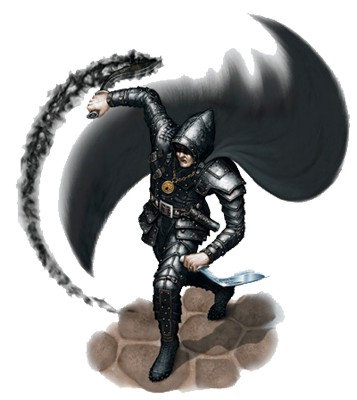 Studded leather armor has little in common with normal leather armor. While
leather armor is a hardened shell, studded leather armor is soft and supple
with hundreds of metal rivets affixed. The rivets are so close together that
they form a flexible coating of hard metal that turns aside slashing and cutting
attacks. The soft leather backing is little more than a means of securing
the rivets in place.
Studded leather armor has little in common with normal leather armor. While
leather armor is a hardened shell, studded leather armor is soft and supple
with hundreds of metal rivets affixed. The rivets are so close together that
they form a flexible coating of hard metal that turns aside slashing and cutting
attacks. The soft leather backing is little more than a means of securing
the rivets in place.
Campaign Use: Studded leather armor is known as "poor man's mail" because
of its metallic components and low price. It is more common among the general
population than most people would first believe because, unlike other types
of mail armor, studded leather is relatively easy to make. While a soft leather
backing is the most durable and comfortable, any stout cloth can be used as
a backing for the rivets. The rivets themselves are also easy to acquire,
as everything from nails to pebbles have been substituted at one time or another
in times of desperation. In general, as long as the backing is secure and
the rivets are hard enough to withstand a glancing blow, the armor so comprised
should be considered studded leather for purposes of weight and protection.
Studded leather, like brigandine (described later), is commonly worn by pirates
and other seafarers. The protection afforded is better than normal leather
armor, which is an important point during sea combat when a shield may not
be practical (a shield is useless when climbing or fighting in a ship's rigging).
With regard to swimming, the weight of studded leather is significantly less
than metal armor, and the flexibility of the soft leather backing is better
for such demanding activity. Indeed, for short times in the water, it is as
easy to maneuver in studded leather as it is to move in a normal leather breastplate.
Therefore, most seagoing mercenaries and pirates prefer to wear studded leather
as their all-purpose armor. Trained marine contingents, however, whose main
function is boarding, usually wear normal leather and carry a shield. Miserly
merchants, who shave pieces of gold more than they like to admit, will often
buy studded leather to outfit their hired guards. However, these copper-pinchers
pay for the protection one way or another, as studded leather tends to wear
out rather quickly. Not only does the soft backing wear out as quickly as
thick clothing, but the metal studs can be affixed only by driving them through
the leather, considerably weakening the overall strength of the backing. Eventually,
the holes open up and the rivets drop out. Studded leather is also prone to
the same problems of sweat, grime, and insects as padded armor.
Spiked
Leather
A
variation of studded leather that is sometimes seen among barbarians of northern
climes (and, oddly, among some hill giant clans) is spiked leather. Much as
it sounds, spiked leather armor is studded leather armor in which the rivets
have been augmented by sharp spikes. (Most intelligent beings would be worried
about mounting spikes into their armor, just in case they should trip and
fall, not to mention the problems packing or storing the armor). Overbearing
and grappling while wearing such armor inflicts additional damage based on
the wearer's size. A small creature inflicts 1-2 points of piercing damage,
a man-sized creature inflicts 1-3 points, and a large creature inflicts 1-4
points. These values are considered for each individual attack, not for every
round that a creature is grappled. Spiked armor is usually made specially
for the wearer and costs about 150% of the price of a normal set of studded
leather. Spiked armor is occasionally used to equip gladiators, pit fighters,
and other specialists.
Hide
Armor (AC 6):
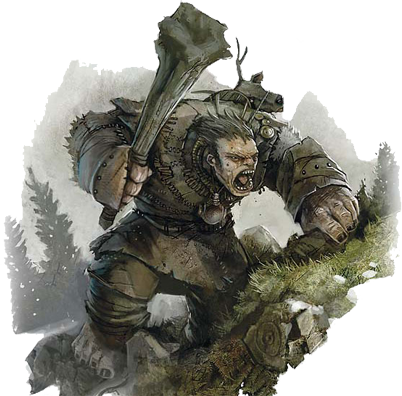 Hide armor is made from the thick hide of a very large animal (an elephant,
for example) or from many layers of normal leather from common animals, like
cows.
Hide armor is made from the thick hide of a very large animal (an elephant,
for example) or from many layers of normal leather from common animals, like
cows.
Campaign
Use: Hide armor is much too thick, heavy, and inflexible to be used much in
the advanced human cultures. Its weight is comparable to chain mail, but its
protection is less. However, among the barbaric humanoid masses throughout
the dark forests and misty jungles of the world, hide armor is common. Because
of its simple construction, any race with Low Intelligence or better can make
suitable hide armor. All that is required is a dead animal and someone to
wear its skin. Since no effort to tan the hide is necessary to get basic protection,
creatures with a desire for excellent protection at a fair price (i.e., usually
free) find hide armor ideal for everyday use. Proper tanning, of course, improves
the armor's life (and acceptance in polite society).
The smell of untanned armor, as any ogre can testify, is something a warrior
must get used to. As mentioned in the section on leather armor, the stiffness
that results when hide armor dries completely isn't considered a drawback
by humanoids. (In fact, without that stiffness, the hide would lose one level
of armor class protection.) For only a little bit of work, any humanoid worth
his hit dice can start adventuring at AC 6 and begin hunting for a shield.
Ironically, while leather armor may allow greater freedom of movement, durability,
and a more pleasant appearance and smell, hide armor is actually two levels
of protection better (AC 6 instead of AC 8). It illustrates that humans trust
their dexterity and intelligence to aid in avoiding wounds during combat,
while less-intelligent humanoids typically rely on reducing the chances of
a vital strike with a thicker armor.
Like padded armor, hide armor is often decorated to show tribal allegiances.
Commonly, the type of creature used to make the armor is sufficient to denote
clan alliance, as with the Hydra clan fire giants or the Black Bear ogres.
Unique to the humanoid races is the habit of affixing some part of one's notable
kill to one's hide armor. While this doesn't affect the armor class rating
of this armor in any substantial way, it does tend to make one less popular
around the civilized campfire but more important around the humanoid or barbarian
camp. Importantly, these trophies, which often include such grisly things
as skulls, scalps, teeth and claws, are considered a sign of ferocity and
ruthlessness and are therefore seen most commonly among high leaders and shamans.
The
equivalent of hide armor among humans and demihuman races is layered leather
armor, wherein many layers of normal leather armor are bonded to one another
to form a heavy, thick plate of protection. This armor is considered hide
armor with regard to weight and cost, but does not suffer the problems of
odor and disease seen in hide and padded armors. Few human cultures employ
hide armor extensively. Most notably, certain northern barbarian tribes commonly
wear thick hide armor. Some of these tribesmen actually believe that the hide
armor gives them animal-like strength and powers, and that human armors like
chain and plate mail actually rob them of their innate combat instincts.
While this may be dismissed as ignorant superstition, there are shamans of
the northern wastes who tell great tales of famous suits of hide armor, blessed
with the spirits of the animals from which they came. Whether or not special
hide armor exists (like the White Skin of Umpluutu, which allows the wearer
to shapechange into a polar bear) is up to the DM, but hide armor offers unique
avenues in a barbarian or primitive campaign.
Scale
Mail (AC 6):
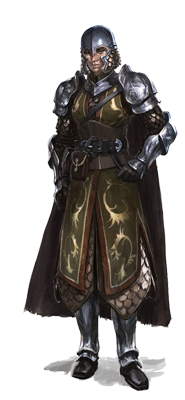 This is a coat of soft leather covered with overlapping pieces of metal, much
like the scales of a fish. It is just as heavy as chain mail, but offers slightly
worse protection. It has no significant advantages over hide or brigandine
armor.
This is a coat of soft leather covered with overlapping pieces of metal, much
like the scales of a fish. It is just as heavy as chain mail, but offers slightly
worse protection. It has no significant advantages over hide or brigandine
armor.
Campaign
Use: Scale mail is an old type of armor, much like splint mail (described
later). It never became popular in western medieval culture for very long;
its production was found to be too time-consuming and thus less efficient
to make in comparison to other armor types. In the AD&D® game context, scale
mail is most common in Dark Age periods, in foreign cultures, or in those
areas where its materials are unusually plentiful. Some human cultures, notably
those similar to the Byzantines and other eastern and southern kingdoms, did
not pursue the evolution of armor made of large plates, but rather chose to
make use of small plates.
Where
metal is not forged but is instead cut from sheets of malleable metal ores,
the technology of scale mail and its successors (splint, brigandine, and banded
armor) predominates. This is not a matter of primitive versus civilized, but
rather two separate approaches to the same problem. Where western cultures
stress protection, eastern cultures seek to maximize flexibility (and ventilation
in the hotter climates). The scales in scale armor are made smaller in order
to make the suit more flexible and comfortable when worn. Indeed, in this
respect, scale mail far exceeds either plate or banded mail. However, all
those scales require more maintenance, as the more items attached to an armor's
backing, the greater the chance some will fall off.
Scale
armor not properly maintained loses one level of armor class protection. Scale
mail suffers the same problems of dirt, grime, lice, and odor that studded
leather and padded armor suffer. Scale mail does offer protection as good
as that of brigandine for the same price and at a comparable weight. The choice
between scale mail and brigandine armor is likely to be determined by the
nature of the cultures in the DM's campaign world.
Sea
Elf Scale Mail:
The
most intricately constructed demihuman scale mail is found in the undersea
kingdoms of the sea elves. More as a matter of appearance and ceremony than
for additional protection, the sea elves adapted the idea of scale mail to
their own peculiar designs. Their armor can be worn underwater, as it is made
of metals that do not rust, and the scales are affixed to a backing of eel-skin,
which does not disintegrate as leather does in salt water. Brought forth only
in times of war or of great ceremony, this expensive armor is worn only by
the noble elven elite. This scale mail is unique among others for its beautiful
silver coating. Some armorers wonder whether this coating is silver, platinum,
or even mithril. It is generally agreed that the rare scale mail of the sea
elves is nearly as valuable as elven chain mail.
Coin
Armor:
A
variant of scale mail is armor made with the common coins of the realm. This
coin armor is seen only rarely, and then usually among dignitaries and high
generals. Each set of armor can stock a large quantity of coins (up to 1,000!).
Rarely are they stolen, however, as the people who are rich enough to wear
them are also rich enough to see to their personal security. There are many
variations possible, from armor scaled wholly of gold or silver coins to mixed
suits wherein the coins themselves are arranged in a personal, family, clan,
or other heraldic pattern.
Brigandine
Armor (AC 6)
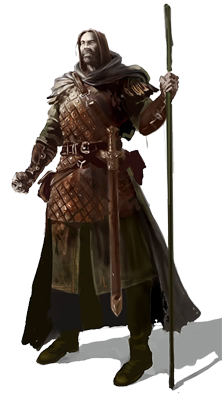 A development of both scale mail and studded leather, brigandine armor is
composed of a layer of small metal plates riveted to an undercoat of soft
leather, thick cloth, or coarse canvas. A further overcoat of cloth is applied
to the exterior of the suit, making for a layered protection that is lighter
than scale mail. An alternative configuration is for the plates to be sandwiched
between two layers of soft leather.
A development of both scale mail and studded leather, brigandine armor is
composed of a layer of small metal plates riveted to an undercoat of soft
leather, thick cloth, or coarse canvas. A further overcoat of cloth is applied
to the exterior of the suit, making for a layered protection that is lighter
than scale mail. An alternative configuration is for the plates to be sandwiched
between two layers of soft leather.
Campaign Use: Brigandine is a light armor of composite construction, often
worn by brigands and other rogues. The armor is essentially a variant of studded
leather with an overcoat of cloth. The cloth covering serves both to strengthen
the entire framework as well as to make the armor less conspicuous from a
distance. Brigandine armor is quieter than chain, splint, or banded mail,
but less quiet than studded leather or leather armor. Brigandine weighs more
than hide but less than scale mail. It is generally more flexible than hide,
but its three layers make it somewhat stiffer than scale mail.
Brigandine
armor is generally the best armor a run-of-the-mill village armorer can make
and still get good results. For anything with a higher armor class, a professional
master armorer is required. This means that brigandine armor is the highest
level of protection afforded many low-level AD&D® game cultures and campaigns.
This represents the limit for the early Middle Ages period AD&D campaign.
If a campaign resembles the Dark Ages more than the Age of Chivalry, scale
mail and brigandine armor probably represent the pinnacle of personal armor.
Pirates and bandits (i.e., brigands) find that brigandine can be made from
anything on hand from sails to canvas sacks, and from coins to brass shavings.
Such armor still offers decent protection against most slashing attacks (the
most common types encountered in these professions).
As
mentioned, brigandine is easier to muffle than most metal armors and mails
and thus is the armor of choice among many rogues and the less reputable members
of the campaign society. Rangers often own a set of brigandine as a field
combat backup to their normal armor of either studded leather or leather.
Poor or novice rangers and warriors might be able to afford or acquire brigandine
armor when other armors might not be accessible. Brigandine armor can also
be useful for smugglers, allowing items to be concealed within its multiple
layers.
Not
only coins and precious metals might be concealed, but treasure maps, personal
defense traps, and concealed weapons are all possibilities for the clever
character. Whether these are actual machinations of devious minds or just
rumors spread to discourage personal thievery is a subject of some debate
among adventurers and legal authorities. What is known is that it is possible
to conceal such items, either within the padding or by interleaving them with
the metal plates. This potential for use (or abuse) of brigandine armor in
the campaign should not be overlooked by the DM or player. Secret pockets
for use by thieves or prestidigitators might be revealed in the heat of combat,
or local authorities may miss a valuable clue the PCs are lucky enough to
discover on their own. Much like gnomish workman's leather (described later),
an adventurer's set of brigandine may hold many welcome or unwelcome surprises.
Chain
Mail (AC 5):
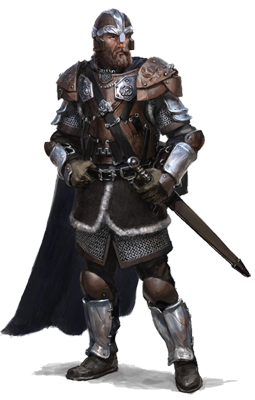 Chain mail is made of interlocking metal rings. It is always worn over a layer
of padded fabric or soft leather to prevent chafing and lessen the impact
of blows.
Chain mail is made of interlocking metal rings. It is always worn over a layer
of padded fabric or soft leather to prevent chafing and lessen the impact
of blows.
Campaign
Use: Chain mail is the standard medium armor in most fantasy campaigns. In
many places, it is so common that the price of a good suit of chain mail may
actually be cheaper than less sophisticated armors like scale mail and brigandine.
This makes the appeal of chain mail armor very high indeed. Chain mail is
only slightly heavier than hide or brigandine armor and much lighter than
any of the plate armors. Important to the wearer, however, is the fact that
the weight of a suit of chain mail does not rest evenly upon the body. Rather,
most of the burden of a chain suit rests upon the shoulders, making chain
armor feel heavier than it really is.
In
game terms, this means chain mail can be worn for only about a day before
the shoulders of even the strongest warriors begin to fatigue. Experienced
warriors usually carry a second set of lighter armor (often leather or studded
leather) for use when traveling or at night when not on watch. Optional Rule:
Prolonged shoulder fatigue from wearing chain mail more than one day at a
time affects combat (-2 to hit) and leads to headaches and backaches. In general,
chain mail is worn by mid-level fighters, guardsmen, mercenaries, and men-at-arms
with some official capacity. The price of chain mail is equivalent to many
years income for most peasants, and is thus out of reach for most common folk.
However,
some middle-class families have a set or two of heirloom chain mail armor
handed down from glorious days past for use in dangerous days to come. Typically,
town guards and noble patrols are bedecked in chain mail armor. It is perfect
for short duty tours and gives the noble warrior a great advantage over the
local rabble. Just the difference between chain mail and leather armor alone
can give the officer a significant advantage over most ruffians. Anyone wearing
chain mail armor with any sort of heraldic crest or uniform is usually assumed
to be a local official of some kind by the experienced and perceptive traveler.
In
general, chain mail is the basis for all of the more advanced and more protective
armors found in most AD&D® game campaigns. The potentially low cost of chain
mail is a reflection of the fact that many sets of chain mail are bought as
a base for banded mail and the more sophisticated plate armors. Because chain
mail armor is not usually worn for long periods at a time, its underlying
padding rarely suffers the problems of padded armors. The metal mail, however,
will rust if not oiled and scrubbed with a wire brush weekly. After a month
of neglect, chain mail armor loses one level of armor class since it is no
longer as flexible and links may have begun to rust. (Naturally, this applies
only to ferrous armor mail and not to chain mail constructed of nonferrous
metals). Chain mail is certainly the best armor value for adventurers who
cannot yet afford the heavier armors.
Ring
Mail (AC 7):
This form of chain mail is made by sewing large metal rings to a leather or
cloth backing. Ring mail has the same role in early-period campaigns that
chain mail has in later ones. In later campaigns, it is more expensive to
buy than chain mail, weighs a comparable amount, provides worse protection
(AC 7), and suffers all the maintenance problems of padded and studded leather
armor. Few human groups, other than town militias and bandit gangs, use ring
mail to any significant degree.
Banded
Mail (AC 4): 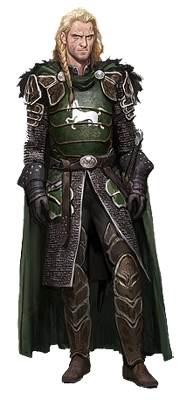
Banded mail armor is made of overlapping horizontal strips of laminated metal
sewn over a backing of normal chain mail and soft leather backing. Lamination
in this context refers to a process in which many thin sheets of metal are
hammered or riveted together to form each individual metal strip.
Campaign
Use: This type of armor is most commonly worn by eastern warriors and would
be as common as plate mail in a culture based on the Turks, for example, late
period Mongols, or the Japanese. In a western campaign, banded mail can be
considered to be the precursor of plate armor. Since banded mail inevitably
will have gaps between the metal strips, however, the total protection of
vital areas is not quite as good as heavier plate armors.
The
result is the slightly poorer armor class rating of banded mail. The strength
and flexibility of chain mail makes it ideal for protecting the jointed areas
where large metal plates are traditionally incapable of providing adequate
protection. One advantage of this metal-and-chain arrangement over chain mail
alone is the fact that the construction of banded mail naturally restricts
movement of the metal plates across the torso. The beneficial side effect
is that the weight of the armor is more evenly distributed on the wearer,
making it easier to wear banded mail for longer periods of time.
In
game terms, while banded mail does have an overall higher level of protection
than normal chain mail, the durability of banded mail, especially at the joints,
is about half that of a standard suit of chain. While a fine set of chain
armor might last six months or more, a set of banded mail rarely lasts three
months, even with constant upkeep.
Much like chain mail, ferrous metal bands
are subject to rust. However, since the metal strips found in banded mail
are already inflexible and designed to remain that way, the armor class of
rusty banded mail is no different from that of a new suit. However, the estimation
of one's peers would certainly be diminished, as a well-tended suit of banded
mail can gleam most beautifully if cared for properly.
Splint
Mail (AC 4):

Splint
mail is a variant of banded mail in which the metal strips are applied vertically
to the backing of chain, leather, or cloth rather than horizontally as in
banded mail.
Since the human body does not swivel in mid-torso as much as
it flexes back to front, splint mail is more restrictive in battle. In game
terms, splint mail is to banded mail as scale mail is to brigandine: splint
mail is the style of the earlier and less efficient armoring techniques.
Much
like scale and ring mail (q.v.), splint mail will be used by the less advanced
cultures and poorer warriors. Its relatively low street price in a western
campaign when compared to banded mail and even chain is due to the fact that
few western warriors will even touch a set of splint mail unless they are
destitute or desperate.
The protection splint mail affords is equivalent to
that of banded mail, but it is much more fatiguing to wear in a lengthy battle.
Furthermore, broken splints tend to work inward toward the wearer in the course
of a battle.
More than a few warriors have found themselves painfully cut
across the ribs when broken banded mail would have merely shifted up or down.
Maintenance problems for splint mail are otherwise the same as for banded
mail. For characters with a light purse, splint mail can be picked up in seedier
armor shops.
Its price makes it ideal for adventurers who want the extra bit
of protection over chain mail.
Plate
Mail (AC 3):
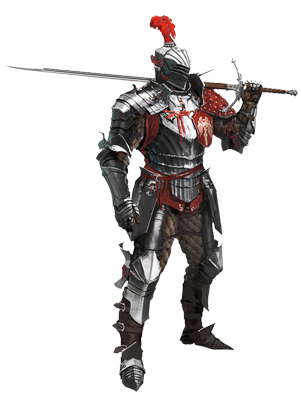 Plate mail is a combination of chain or brigandine armor with metal plates
covering the vital areas such as the chest, abdomen and groin. Similar in
construction to bronze plate mail, true plate mail comprises heavy steel plates
riveted to a sturdy backing of chain and leather.
Plate mail is a combination of chain or brigandine armor with metal plates
covering the vital areas such as the chest, abdomen and groin. Similar in
construction to bronze plate mail, true plate mail comprises heavy steel plates
riveted to a sturdy backing of chain and leather.
These
metal plates are often better constructed than those found in bronze plate
and banded mails, relying on superior metallurgy and advanced lamination techniques
to produce a lightweight steel with excellent combat characteristics. Brigandine
backing for this type of armor is rare, because the stiffness of brigandine
armor makes this type of backing an unpopular choice among plate armorers
and warriors alike. For all of these reasons, plate mail protects the human
body more effectively than bronze plate mail.
Campaign
Use: The development of plate mail heralded the beginning of the age of chivalry
and knighthood. Associated most often with classic French medieval culture,
the names given to the segments of plate mail reveal their French origin to
this day. The most important metal plate on the armor is called the plastron-de-fer,
or breastplate. It protects the vital chest and abdominal areas from attack.
Typically, the shoulders were protected by metal shoulder guards called epaulieres.
Lower leg protectors, called grevieres (or greaves), and metal-plated chain
gloves, or gauntlets, are also common accessories to a plate mail suit. Any
manner of helm is also desirable (see the section on Helms). Plate mail is
the most common form of heavy armor in fantasy campaigns.
It
provides maximum protection for a fraction of the cost of field or full plate
armor, and can take month after month of grueling combat punishment. It is
only moderately heavier than banded or chain mail, and because of its custom
fitting and sturdy straps, wears easier than either. Because the plates are
carefully fitted to combine with the chain suit beneath, the layer of leather
or padding beneath the chain is often much thinner and more flexible than
that found in banded or brigandine armor. Many long years have gone into perfecting
the construction of plate mail, which makes even the most basic of suits a
wonder of medieval engineering.
With regard to cost, the purchaser of a set of plate mail may have to fork
out a considerable sum of money compared to banded mail, but no wearer of
plate mail doubts for long the value and summary wisdom of his purchase. Knights,
royal guards, and mercenary captains often wear plate mail. Even as a prize
of battle, plate mail is infinitely easier to fit to a new owner than either
field or full plate armor. Plate mail is the preferred protection of the vast
percentage of the world's most experienced warriors, because it is not nearly
as cumbersome to don or remove as other heavier types of armor.
It is a matter of pride among many kingdoms that even the slightest improvement
to the general plate mail design was quickly attributed to the armorer who
invented the alteration and the king whose wisdom it was to accept the change.
As such, most sets of plate mail were constantly upgraded throughout the known
world, and now are very similar indeed. In fact, the perfection of the basic
plate mail design was so nearly complete that many armorers had already begun
devoting most, if not all, of their time and resources to working field and
full plate armor with similar care and precision. Plate mail is the heaviest
armor commonly used by adventurers, both as a matter of pride and for the
general necessities of daily use and efficiency.
Field
Plate Armor (AC 2):
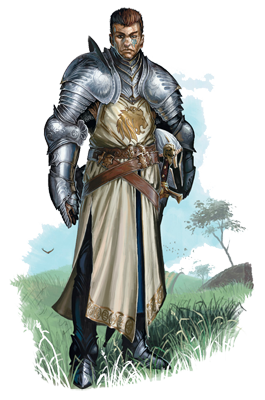 Field plate is actually a more commonly used form of full plate armor (described
later). It consists of shaped and fitted metal plates riveted and interlocked
to cover the entire body. Like plate mail, a set of field plate usually includes
gauntlets, boots, and a visored helmet (see Helms). A thick layer of padding
must be worn under the armor.
Field plate is actually a more commonly used form of full plate armor (described
later). It consists of shaped and fitted metal plates riveted and interlocked
to cover the entire body. Like plate mail, a set of field plate usually includes
gauntlets, boots, and a visored helmet (see Helms). A thick layer of padding
must be worn under the armor.
Campaign
Use: This armor is rarely used, except by noble knights on a military campaign.
In theory, the bulk of a set of field plate armor is so evenly distributed
over the whole body that the encumbrance rating of field plate compares quite
favorably with that of plate mail and banded mail. In practice, the increased
protection is paid for with reduced mobility and increased fatigue. Each suit
of this extremely rare and expensive armor is custom-made and fitted for its
prospective wearer.
Only
a master armorer can create field or full plate armor, and only a master armorer
can re-size captured pieces of a suit for a new owner. The new owner must
be of at least a similar size and build as the previous owner, or the effort
required to modify the piece in question exceeds the expense and effort necessary
in forging an entire new set. Aside from its expense, the main disadvantages
of field plate armor are the lack of ventilation through the suit, which make
moisture and fungus a problem, and the time required to put it on and take
it off. As detailed in the AD&D® 2nd Edition Player's Handbook, 1d6+4 rounds
are required to dress in field plate armor with outside assistance.
Triple
that amount of time is required if the wearer is alone. Similarly, it takes
1d4+1 rounds to remove such armor, and half that time (fractions rounded up)
if pressed for time or assisted by an attendant (see Full Plate Armor). Field
plate armor is typically used by the high knights of a kingdom, like King
Arthur's legendary Knights of the Round Table, for everything except formal
ceremonies and triumphant battle celebrations. Full plate armor is reserved
for such occasions where style is more important than combat. Field plate
can be fixed much more cheaply and easily than full plate, and is built to
withstand the rigors of long-term use and combat.
The
entire body is encased in metal plates, and even the joints are protected
with metal caps and sturdy chain mail. A great helm bearing the emblem of
the house or name of a legendary knight is common and is one of the few ways
a knight can recognize a friend or foe from a distance. Field plate, while
expensive and painstakingly crafted by master armorers, is normally not adorned
with many trappings or embellishments. Since legendary knights make a habit
of battling great armies and dragons almost daily, their armor rarely lasts
longer than a year without needing to be completely replaced.
A
DM may decide that being allowed to wear field or full plate armor is a sign
of nobility or knighthood in his campaign. In such campaigns, wealthy warriors
had better have a legitimate noble crest or recognized royal patron before
parading themselves about town.
Optional Rule: This rule may be invoked if
a player insists on wearing badly repaired or patchwork plate mail. Following
every strong jolt to the wearer, whether from a good hit in battle or a fall
from a cliff, the material binding the patchwork plate to the backing (as
stated at the time of repair) must make a saving throw versus Crushing Blow.
Failure means the plate falls off, while success means the next saving throw
is made with a -1 penalty to the roll. Note that this penalty is cumulative,
so any patchwork plate is bound to fall apart eventually.
Full
Plate Armor (AC 1):
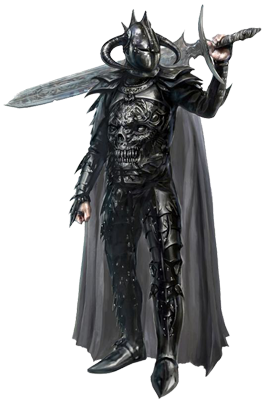 Full plate armor is the best armor a warrior can buy, both in appearance and
protection. The perfectly-fitted interlocking plates are specially angled
to deflect arrows and blows, and the entire suit is carefully adorned with
rich engraving and embossed detail.
Full plate armor is the best armor a warrior can buy, both in appearance and
protection. The perfectly-fitted interlocking plates are specially angled
to deflect arrows and blows, and the entire suit is carefully adorned with
rich engraving and embossed detail.
Campaign
Use: Suits of full plate armor are as rare as powerful magical items in most
fantasy campaigns. Magical sets of full plate are artifacts to be treasured
and hidden away, the objects of glorious quests. In most campaigns, the number
of sets of full plate armor can be counted as easily as the numbers of crown
knights who owe their allegiance to the king. In many kingdoms, it is a crime
to possess a set of full plate armor without royal permission, as a wise king
keeps any armorer capable of such craftsmanship at his beck and call. Full
plate armor is one of the greatest gifts a great lord can bestow upon his
followers. It is a prize as coveted for the status it confers as its monetary
value.
A suit of full plate armor will often be a gift presented to great knights
upon great service to the realm, or as an incentive to attract a knight errant
of unquestioned prowess to the king's private circle. In addition, full plate
armor is the most technologically advanced armor available in the later medieval
and high chivalry settings. The special touches and custom enhancements added
by the few living master armorers are what give full plate armor its increased
armor class rating over the more traditional forms of field plate. At prices
that start at 4,000 gold pieces for a simple, unadorned suit, full plate armor
represents the crowning achievement of the armorer's ultimate goal--to forge
for man a new skin of steel, as flexible as his own, but as invulnerable as
anything in the land. This increased protection comes only with a price. While
full plate armor wears well when correctly fitted, it is cumbersome to don
or remove without assistance. Herein enters the attendant.
For
most knights, the attendant is a vassal or squire who tends to the knight's
every need. He sharpens his lord's sword and brushes his horse. However, the
great knight chooses his attendant carefully, for he knows his life may depend
on this decision. Without the assistance of a capable attendant, a knight
requires 1d10+10 rounds to don his armor. An attendant cuts this time by half.
As most combat veterans know, cutting the average armoring time in half can
mean the difference between being at the battle and missing it entirely! Warriors
in a hurry can cut this dressing time by half again.
The
ramifications of this haste is that a knight and his attendant who are extremely
lucky might, at best, be able to get dressed in only 3 rounds (i.e., best
roll of 1, add 10 equals 11 rounds; 11 rounds cut in half for attendant's
assistance equals 6 rounds; 6 rounds halved again for rushing yields 3 rounds).
However, a knight hurrying in this manner suffers penalties in combat. His
straps are not adjusted correctly, meaning his plates are too loose or too
tight and will hamper his overall effectiveness in battle. The knights suffers
a -1 to all attack rolls and his armor class likewise drops one place, meaning
his hasty dressing has given him armor equivalent in protection to that of
field plate armor.
If
a knight discovers that his loose fittings are causing him to miss his mark
or be struck by his enemies too often, he need only spend as many rounds tightening
his straps as he neglected by rushing his preparations (twice that if unattended,
of course). Example: Sir Hujer rolls a 6 on 1d10 when attempting to don his
armor, thus needing 16 rounds. An attendant reduces this to 8 rounds, and
rushing reduces this further to 4 rounds. The rushing penalties would be removed
if Sir Hujer took 4 rounds (attended) or 8 rounds (unattended) to readjust
his armor.
Gnomish
Workman's Leather Armor (AC 7):
Gnomish workman's leather armor is a variation of high-quality gnomish leather
armor (as described in the Equipment Chapter of The Complete Fighter's Handbook).
Gnomish workman's leather is adorned with dozens of tiny tool holders and
pouches, typically filled with the most bizarre collection of coins, nails,
tools, weapons, widgets, and sprockets ever assembled on one body. For this
reason, a set of gnomish workman's leather provides protection identical to
studded leather armor.
Campaign
Use: Typically, gnomish workman's leather is as silent as normal high-quality
gnomish leather armor (no Thieving Skill Armor Adjustment). However, this
is before a gnomish workman has gotten anywhere near it. As with most things
of gnomish design, the whole is a rather sundry compilation of many disjointed
parts. Strange inventions, secret compartments, locked and trapped pockets,
and a dizzying array of tool holders and layered item racks are added, modified,
moved, and camouflaged almost daily. From week to week, a gnomish workman's
armor may change drastically in appearance and function. The armor has a stowage
capacity of 10 lbs., up to half of which can be considered hidden. Importantly,
the special benefits of gnomish high-quality leather armor are lost when a
gnomish workman begins collecting items to tuck into this leather garb.
While
a few items on the belt do not significantly ruin this feature of the base
armor, enough gadgets to alter the armor class cannot help but clink and bang
into each other, crinkle and spill out when the owner bends over, or accidentally
drop off or explode in the most heated battle or flight. Outside of gnomish
society, this type of armor has been rarely seen by non-gnomes. Humans and
elves rarely steal things they cannot use, unless hired to do so, and dwarves,
who might squeeze into a suit if offered, find the concept distasteful and
the appearance much too garish for their otherwise stoic tastes. Halflings
have displayed a weakness for the many secret compartments found in gnomish
workman's leather, and halfling thieves in particular might treasure this
type of armor above all else. Indeed, the black market for gnomish workman's
leather is rumored to be funded entirely by halfling-run thieves' guilds.
This
only adds fuel to any fires of discontent between halfling and gnomish clans.
In human settlements and cities, gnomes only don workman's armor when working
privately, deep in their secret workshops. Since no one around them either
appreciates or respects the trappings of "master craftsmanship," there seems
to be little need to flaunt them. Within the gnomish clan, however, there
is a constant competition between all gnomish craftsmen, among both masters
and apprentices. In some clans, the competitions have become formalized, with
actual categories (most items carried, best personal trap, most secure pouch,
nicest appearance, etc.) and prizes (clan contracts or a special badge to
be sewn onto the armor).
These
contests are held on high festival days, much like a merchant's bazaar (just
another special guild tradition to confuse the newcomer or overnight visitor).
In the largest of clans, many competing craftsman's guilds might sponsor and
support individual designs or candidates. Every craftsman in the hall will
spend long nights tinkering with his own armor to emulate or duplicate the
desired effect. Those who succeed will claim partial credit for "testing and
perfecting" the basic design. Those who fail might offer small sums of gold
for the secret of the new invention.
Elven
Chain Mail (AC 5)
Elven chain mail is the only form of armor made of a legendary elven alloy,
a lightweight silvery steel of great strength. Even without enchantment, elven
chain mail is typically half the weight of its human-forged counterpart.
Campaign Use: The elves guard the secret of making elven chain mail with more
ferocity than they protect even their own children. In the entire multimillennia-long
history of the elven race, the number of elven armorers who learn the secrets
of forging elven steel can be counted on but one hand. Needless to say, these
masters of the art tend to be ancient in the extreme, and the choice of an
apprentice comes but once every thousand years. This is the highest honor
accorded to any single elf, save being chosen by his peers to lead the elven
race.
Apprenticeship is not a gift bestowed by the wealthy or powerful, but chosen
by magical testing in a secret ceremony. Some outsiders would argue that the
training makes the armorer, but tradition holds great sway in elven circles.
Human and dwarven armorers have been able to divine at least some of the secrets
of the elven armorers, but not the most important ones. They know, for example,
that mithril silver, that part of mithril which gives this purest of metals
its glimmer in the moonlight, is somehow alloyed with other materials. The
process of alloying has never been duplicated outside of an elven master forge,
so most armorers believe some form of magical manipulation is involved in
the process somewhere.
Furthermore,
anyone hoping to forge elven armor must be able to see the magical emanations
radiating from it. While this may be done artificially through magic, this
task is geared more toward the elves' natural eyesight. Drow armorers (described
later) work under similar conditions. Naturally, when one has a thousand years
to perfect the skills for one's job, just about anything is within grasp.
The dwarves call this an unfair advantage, while the humans don't even bother
trying anymore. Life is too short, they feel, to waste time on creating something
that would be easier stolen or discovered in a dragon's horde. Elven chain
mail is used by elven troops, both cavalry and infantry.
It
is common among the gray (faerie) elves and advanced elven cultures, but less
common among the high elves. It is extremely rare among the wood elves. Since
the material is so strong and valuable, in those rare instances when a suit
of elven chain mail is damaged to the point of needing repair, the suit is
never discarded, but returned to the armorer for repair or replacement. By
the numbers of suits estimated to exist by human military planners and master
armorers, best estimates are that it might take upwards of ten years to make
just one suit of elven chain. Otherwise, they reason, there would be a lot
more of the armor in use by the elves, and many more suits would be found
in the lairs and treasure hordes of monsters across the realms.
Magical
Elven Chain Mail
Ordinary
elven chain mail is rare in the extreme, but magical elven chain is so precious
a gift that only a handful of suits have been rumored to exist anywhere but
in royal elven hands. In addition to the normal weight and flexibility advantages
of elven chain, magical elven chain mail is so weightless that it can be worn
under one's normal clothes. It is so comfortable and unrestrictive that it
can be worn constantly, even while sleeping. Magical elven chain is so soft
to the touch that it can be worn without any padding beneath it. This makes
magical elven chain the ideal armor for travelers, excluding only the greatest
of knights, who by tradition prefer plated armors over all others. For rogues
especially, a set of magical elven chain mail is a more prized possession
than even full plate armor +1. Adventurers have lost their lives over mere
rumors of magical elven chain.
Drow
Chain Mail (AC 4)
Drow chain mail is a finely-crafted, satiny black metal mesh that does not
encumber its wearer in the least. It is similar, but not identical to, the
magical elven chain mail described previously. It is typically fashioned only
into tunics, as drow elves share their forest-bound cousins' preference for
armor that adequately protects without being overly weighty or restrictive.
Campaign
Use: Much like their cousins in the sunlight, the drow have invented their
own form of special armor. What is known for certain is that drow chain mail
uses adamantite, the strongest metal known, as the principal component of
their mystical alloy. It is mined by myriad drow-allied races in great quantities,
and the drow war machine is wholly dependent on adamantite-related technologies.
This alloy has special properties due to the peculiar nature of the radiation
emanating from the drow homeland, giving even the basest form of the alloy
the equivalent of a magical +1. Drow weapons, shields, armor, etc., all begin
with a +1 bonus, and based on the alloy, the amount of time spent in the forge,
and the secret processes used, it can increase to as much as +5.
The
alloy does not radiate magic in the traditional way (a detect magic spell
reveals no trace of magical properties). Whenever drow-alloyed creations,
including armor, are exposed to direct sunlight, their magical bonuses are
immediately lost and they begin to utterly and irreversibly decay. This happens
even after one short exposure, meaning that even a set of drow armor that
is immediately returned to utter darkness or the nearest drow homeland will
still decay. Physical decay begins 1d12+8 days after exposure to sunlight.
The armor completely falls apart after another 1d12 days have passed.
If
extraordinary precautions are taken, an adventurer could theoretically use
a set of drow armor, if worn only in the dead of night and returned to complete
darkness (e.g., a light-proof chest or vault) before the break of day. However,
the armor must be returned to the drow homeland once every two weeks to be
re-exposed to the radiation. Armor must remain in the homeland two days per
day spent above ground. If the armor is not returned to the underdark before
two weeks have passed, the magic of the armor is permanently lost. Decay then
begins as described above. The fragments of metal that remain after drow armor
deteriorates may be collected and reused for future forgings.
However,
the metal is nonmagical until the forging process imbues the enchantment.
The surface elves contend that these conditions are poor workmanship on the
part of the drow, but scholars have noted many parallels between elven and
drow alloys. For example, one possibility is that just as the strange magical
emanations of the drow homeland aid in the construction of their special adamantite
objects, it has been surmised that moonlight, pure and cool, may have something
to do with the forging of elven mithril armor. The fact that mithril is as
reflective, light, and pure as adamantite is dull, heavy, and dense has not
escaped observation.
What
is certain about the two magical types of armor is that such parallels cannot
be sheer coincidence. Somewhere in the distant past of the two races, when
times were better and before the dark elves retreated to the earthen depths,
there must have been one common armor technology. The drow took the secrets
of forging elven metals with them when they left, but had to discover something
to replace both the mithril and moonlight components of the ancient secret
art. What they eventually discovered, perhaps after many centuries of experimentation,
was a magical alloy more abundant than mithril, yet not as stable as elven
chain.
Dwarven
Plate Mail (AC 2)
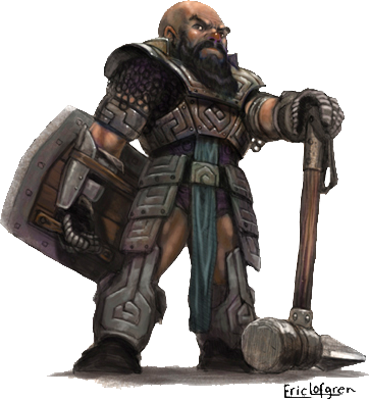 The forged black iron plate made by the dwarves exclusively for their own
warrior leaders is both heavy and unattractive by human and elven standards.
However, dwarves have traditionally placed less emphasis on appearance than
on personal defense. Dwarven warriors who wear dwarven plate are often called "waddling cauldrons" by their enemies due to the bulk of this armor.
The forged black iron plate made by the dwarves exclusively for their own
warrior leaders is both heavy and unattractive by human and elven standards.
However, dwarves have traditionally placed less emphasis on appearance than
on personal defense. Dwarven warriors who wear dwarven plate are often called "waddling cauldrons" by their enemies due to the bulk of this armor.
Campaign
Use: As detailed in both The Complete Fighter's Handbook and The Castle Guide,
high-quality dwarven plate is the boilerplate version of human plate armor.
It is 50% heavier than equivalent mails, making a single suit of dwarven-sized
plate mail armor weigh approximately the same as a set of human-sized plate
mail. Additionally, the denser armor affords protection equivalent to plate
mail +1, and the armor itself saves against equipment damage at +6, in addition
to any bonuses permitted if the dwarven plate in question is also magically
enchanted.
Stories
about dwarven plate armor withstanding the smelting fires of a red dragon's
breath may be boastful exaggeration, but it is an established fact that dwarven
plate often survives an attack that its wearer does not. As mentioned, dwarves
prize combat effectiveness over a warrior's appearance. It is therefore very
rare for the iron appearance of dwarven plate mail to be adorned in any way.
Much like the elves, dwarves do not make dwarven plate for non-dwarves. Not
only is it considered impractical to spend one's time building a suit of armor
no dwarf can ever hope to wear (a waste of time), but the dwarves will admit
to having no skill in working with the peculiarities of the human body.
Dwarves
tend to ignore things like flexible joints, as their range of movement is
already restricted by nature. An ancient dwarven warrior's saying goes something
like "If it doesn't fit, bend it. If it still doesn't fit, break it!" Along
those lines, another popular dwarven saying is "Never let your armor impede
a good fight." Dwarven field and full plate armor do not exist. Not only would
dwarves look like miniature iron golems when so protected, but dwarves prefer
to let their facial expressions speak for them in combat. The problem of free
movement plays a big part in this practical decision as well.
No
human has ever managed to convince a group of dwarves to forge a set of full
plate armor for them. If such a task were even to get past the bargaining
phase, it would quickly become apparent to all concerned that the dwarves
have no experience or knowledge of such constructions and lack the motivation
to learn it. Dwarves themselves claim they'd rather be "beating their hammers
on orc skulls than beating them in the forge." Curiously, gnomes have offered
to give full plate their "best shot" from time to time, but so far, no human
has been brave or foolish enough to accept the offer.
Dwarven
plate mail lasts longer than its human counterpart. As detailed in The Complete
Fighter's Handbook, dwarven plate mail can sustain twice as many points of
damage as normal plate mail (if the optional armor damage point system presented
therein is being used).
Magical
Dwarven Plate Mail
Magical
dwarven plate mail is only as encumbering as ordinary plate mail. The enchantment
is cumulative with the natural +1 to armor class dwarven plate possesses.
Therefore, dwarven plate mail +1 is actually equivalent to ordinary plate
mail +2 for purposes of armor class (but not saving throws). It may be easier
for the DM and player if the base armor class for dwarven plate is remembered
to be 1, equivalent to field plate armor for humans.
